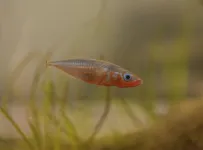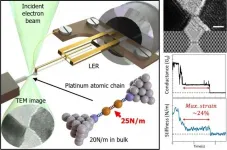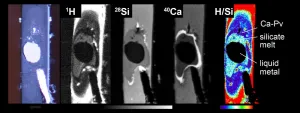(Press-News.org) Psychology researchers at UC Santa Cruz have found that playing games in virtual reality creates an effect called "time compression," where time goes by faster than you think. Grayson Mullen, who was a cognitive science undergraduate at the time, worked with Psychology Professor Nicolas Davidenko to design an experiment that tested how virtual reality's effects on a game player's sense of time differ from those of conventional monitors. The results are now published in the journal Timing & Time Perception.
Mullen designed a maze game that could be played in both virtual reality and conventional formats, then the research team recruited 41 UC Santa Cruz undergraduate students to test the game. Participants played in both formats, with researchers randomizing which version of the game each student started with. Both versions were essentially the same, but the mazes in each varied slightly so that there was no repetition between formats.
Participants were asked to stop playing the game whenever they felt like five minutes had passed. Since there were no clocks available, each person had to make this estimate based on their own perception of the passage of time.
Prior studies of time perception in virtual reality have often asked participants about their experiences after the fact, but in this experiment, the research team wanted to integrate a time-keeping task into the virtual reality experience in order to capture what was happening in the moment. Researchers recorded the actual amount of time that had passed when each participant stopped playing the game, and this revealed a gap between participants' perception of time and the reality.
The study found that participants who played the virtual reality version of the game first played for an average of 72.6 seconds longer before feeling that five minutes had passed than students who started on a conventional monitor. In other words, students played for 28.5 percent more time than they realized in virtual reality, compared to conventional formats.
This time compression effect was observed only among participants who played the game in virtual reality first. The paper concluded this was because participants based their judgement of time in the second round on whatever initial time estimates they made during the first round, regardless of format. But if the time compression observed in the first round is translatable to other types of virtual reality experiences and longer time intervals, it could be a big step forward in understanding how this effect works.
While there are many informal descriptions of time compression in virtual reality from people who have experienced it first-hand, it's still an active area of research. One particularly well-known prior study applied virtual reality time compression to shorten the perceived duration of treatment for chemotherapy patients, but that experiment didn't compare virtual reality with conventional screen formats.
"This is the first time we can really isolate that it's not just that you're playing a video game, or the content of whatever you're seeing," Mullen said. "It's really the fact that it is virtual reality versus a conventional screen that contributes to this time compression effect."
Time compression could be useful in some situations--like enduring an unpleasant medical treatment or passing the time on a long flight--but in other circumstances, it could have harmful consequences.
"As virtual reality headsets get more comfortable to wear for longer periods of time, and as more immersive games are made for this format, I think it would be good to avoid having it become like a virtual casino, where you end up playing more because you don't realize how much time you're spending," Mullen said.
Research on game addiction shows that losing track of time during gameplay can negatively affect a player's sleep cycle and mood. These effects could be more pronounced in virtual reality, but Mullen says game designers can help to minimize the risk, perhaps by integrating a clock that would appear at regular intervals during gameplay.
It will also be important to discover why virtual reality seems to contribute to time compression. In the paper, Mullen describes one possibility, which relates to the fact that, in virtual reality, a player has less body awareness. Psychology Professor Nicolas Davidenko, a coauthor and advisor on the paper, explained why this might be important.
"In virtual reality, when you look down, you might see nothing where your body normally would be, or you might see a schematic of a body, but it won't feel like your body," Davidenko said. "There are theories that we may rely on our heartbeat and other bodily rhythms to help our brain track the passage of time, so if you have a less vivid sense of your body in virtual reality, you might be missing the pulses of this timekeeping mechanism."
Future experiments to test this theory could yield new insights to help designers maximize benefits and minimize harm from time compression as virtual reality technology continues to grow.
INFORMATION:
The COVID-19 pandemic has been shown to have caused a significant strain on the healthcare system and resources in the United States. However, data regarding the impact of the virus on hip fractures, primarily seen in elderly patients, is lacking.
Researchers at Hospital for Special Surgery (HSS) sought to compare characteristics and outcomes of hip fracture patients admitted during the COVID-19 outbreak to patients admitted before the outbreak. They also examined characteristics and outcomes of hip fracture patients with and without the virus. Their findings were presented at the 2021 Spring American Society of Regional Anesthesia and ...
Interim results of a study conducted by researchers at Hospital for Special Surgery (HSS) suggest that oral tranexamic acid (TXA) is non-inferior to intravenous (IV) TXA in preventing blood loss in total knee and total hip replacement surgery. These findings were presented at the 2021 Spring American Society of Regional Anesthesia and Pain Medicine (ASRA) Annual Meeting.1
Previously available information suggests that oral, IV and topical TXA are all effective at reducing blood loss and drastically reducing blood transfusion rates during and after surgery, but research with direct comparisons for each method is limited.
"TXA in orthopedic surgery has become the standard ...
While it has been said that the eyes are a window to the soul, a new study shows they could be a means for understanding diseases of the brain. According to new research by scientists at the UCSF Weill Institute for Neurosciences, retinal scans can detect key changes in blood vessels that may provide an early sign of Alzheimer's, while offering important insights into how one of the most common Alzheimer's risk genes contributes to the disease.
"The most prevalent genetic risk for Alzheimer's disease is a variant of the APOE gene, known as APOE4," said lead author Fanny Elahi, MD, PhD. "We still don't fully understand how this variant increases risk of brain degeneration, we just know that it does, and that this risk is modified by sex, race, and lifestyle. "Our ...
Climate change is exacerbating problems like habitat loss and temperatures swings that have already pushed many animal species to the brink. But can scientists predict which animals will be able to adapt and survive? Using genome sequencing, researchers from McGill University show that some fish, like the threespine stickleback, can adapt very rapidly to extreme seasonal changes. Their findings could help scientists forecast the evolutionary future of these populations.
A popular subject of study among evolutionary ecologists, stickleback are known for their different shapes, sizes, and behaviours - they can even live in both seawater and freshwater, and under a wide range of temperatures. But what ...
Plants have evolved unique immunity mechanisms that they can activate upon detecting the presence of a pathogen. Interestingly, the presence of some nonpathogenic microorganisms can also prompt a plant to activate its systemic immunity mechanisms, and some studies have shown that pretreating agricultural crops with such "immunity-activating" nonpathogenic microorganisms can leave the crops better prepared to fight off infections from pathogenic microorganisms. In effect, this means that immunity-activating nonpathogenic microorganisms can function like vaccines for plants, providing a low-risk stimulus for the plant's immune system that prepares it for dealing with genuine threats. These are exciting findings for crop scientists because they suggest the ...
Researchers at UC San Francisco have observed a new feature of neural activity in the hippocampus - the brain's memory hub - that may explain how this vital brain region combines a diverse range of inputs into a multi-layered memories that can later be recalled.
Using a special "micro-grid" recording device developed by colleagues at Lawrence Livermore National Laboratory (LLNL), the UCSF researchers were able to measure hippocampus activity in study participants undergoing surgery to treat severe epilepsy. They discovered that brain waves travel back and forth across this structure, integrating messages ...
The international scientific community agrees that the latest findings of an FAU research team will revolutionise the entire chemistry of magnesium. The research team have discovered magnesium, which usually has a double positive charge in chemical compounds, in the elemental zero-oxidation state. They have published their ground-breaking findings in the journal Nature.
In the periodic table of elements, magnesium (Mg) is a metal with low electronegativity, which means it does not easily attract electrons but easily loses both the electrons in its outer shell during chemical reactions. It therefore only exists in nature as a compound ...
Ishikawa, Japan - Today, many well-studied materials in various fields, such as electronics and catalysis, are close to reaching their practical limits. To further improve upon modern technology and outperform state-of-the-art devices, researchers looking for new functional materials have to push the boundaries and explore more extreme cases. A clear example of this is the study of low-dimensional materials, such as monoatomic layers (2D materials) and monoatomic chains (1D materials).
It has been proved time and time again that low-dimensional materials exhibit exotic properties that are absent in their 3D bulk counterparts. For example, monoatomic chains of metals like gold ...
High-temperature and high-pressure experiments involving a diamond anvil and chemicals to simulate the core of the young Earth demonstrate for the first time that hydrogen can bond strongly with iron in extreme conditions. This explains the presence of significant amounts of hydrogen in the Earth's core that arrived as water from bombardments billions of years ago.
Given the extreme depths, temperatures and pressures involved, we are not physically able to probe very far into the earth directly. So, in order to peer deep inside the Earth, researchers use techniques involving seismic data to ascertain things like composition and density of subterranean material. Something that has stood out for as long as these kinds of measurements have been taking place is that the core is primarily ...
The ease with which anyone can create online content for free, especially on social media, has led to superabundance of information being one of the defining characteristics of today's communication systems. This situation has resulted in increasingly intense competition for attention, which has become a scarce good. The researchers from the Complex Systems group (CoSIN3) at the UOC's Internet Interdisciplinary Institute (IN3) María José Palazzi and Albert Solé --professor at the Faculty of Computer Science, Multimedia and Telecommunications?--, led by Javier Borge, have participated in the design of ...


